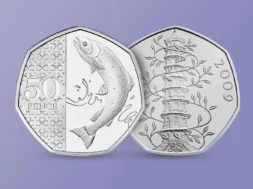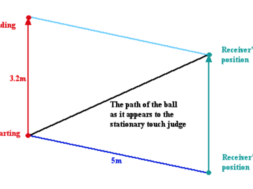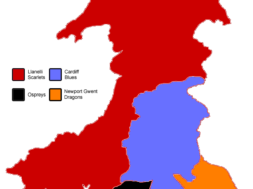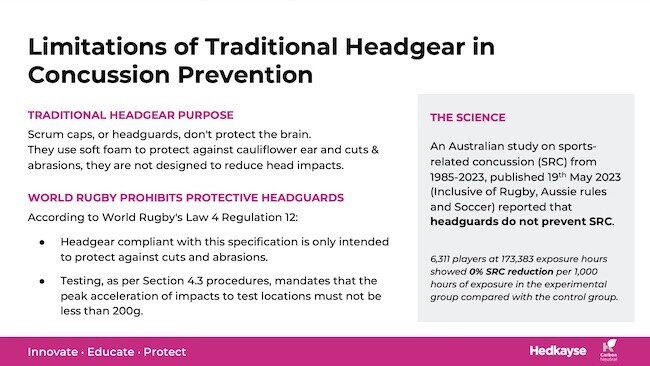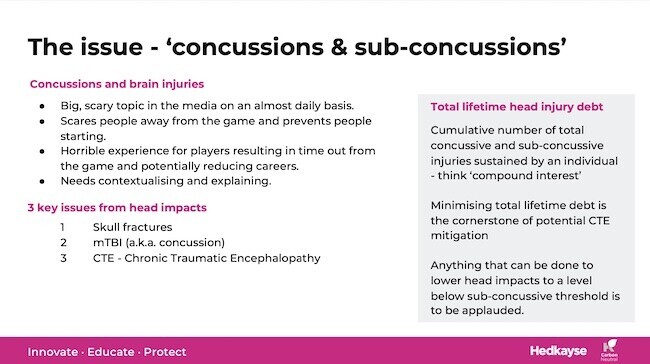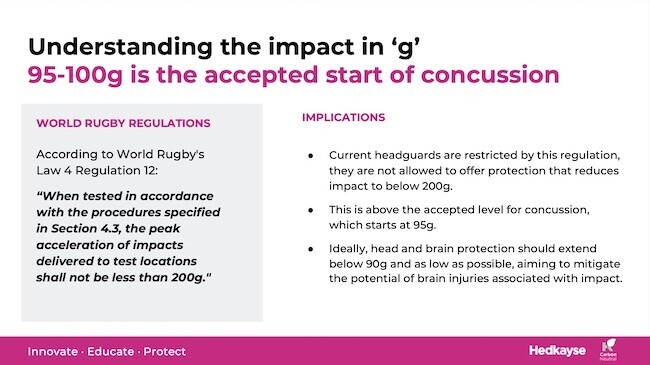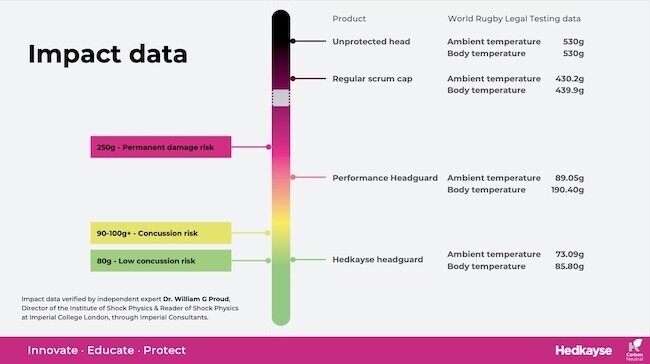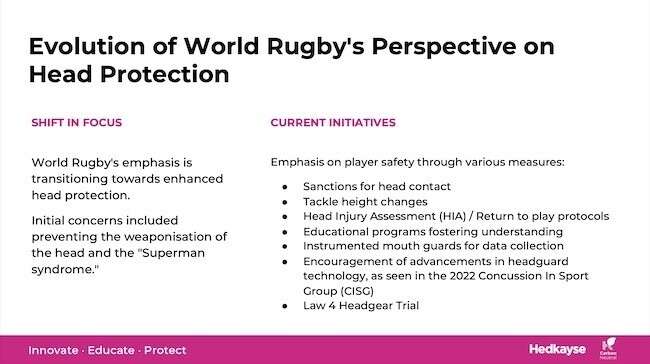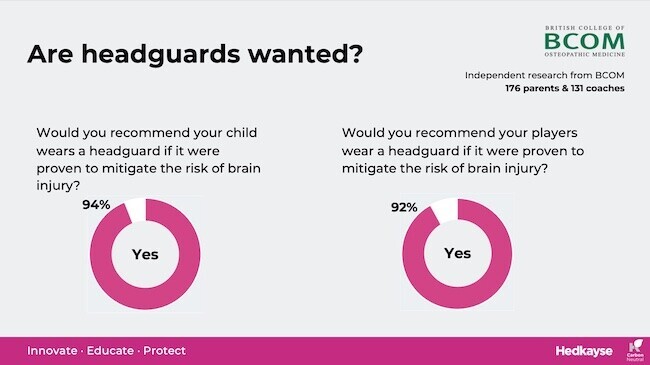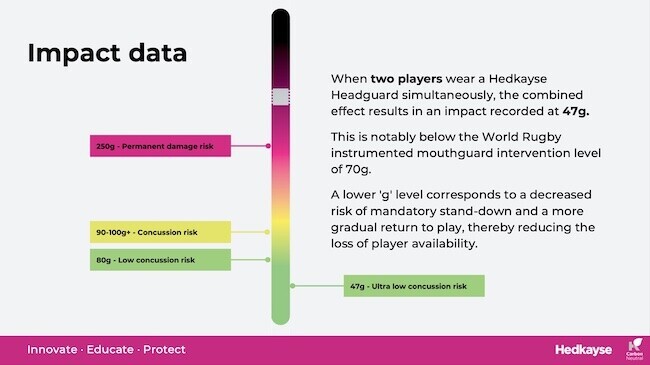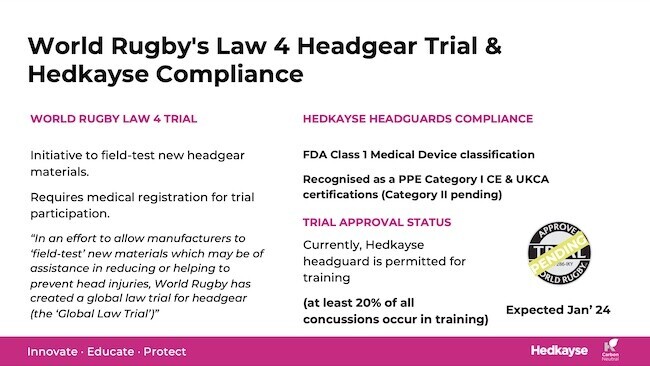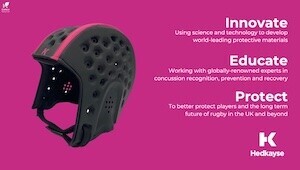
Rugby Headguards – Hedkayse Headguard Review
It works but it’s not the solution!
This is just another scrum cap they don’t protect heads, it’s no different.
Currently World Rugby’s Law 4 states head gear is only intended to protect from cuts and abrasions and not protect from impacts.
Whilst there have been vast improvements around head injury assessment protocols there is clearly room for improvement. There is a better understanding of concussion and typical forces that can cause concussion. (C.a. 95-100 G dependant on the individual) Less is known about sub concussive injuries (Around 75-95G). There is a growing belief that multiple sub-concussive injuries can lead to long term brain injury, research is ongoing. 20% of these occur in training.
The Hedkayse head guard is designed to cover the whole head including the back. Typical foam thickness is 25mm (1 inch). The head guard does not restrict hearing. Doctors, engineers, players and coaches were consulted during the design phase.
The same team is developing a version for women given their differing physiology.
The Enkayse foam is very different from previous protective helmets. E.g., Cycle helmets the foam used in other head protection is polystyrene. On impact the foam is crushed to reduce the impact once used it cannot be used again. Encase foam is polyurethane foam which also dissipates the energy of impact but its physical properties mean that it returns to its original shape after the impact so can be repeatedly.
Head guards just can’t protect against concussion
Currently there is no way to reduce rotational head impacts or whiplash injuries. (Under development) Hedkayse has little effect or no effect with these however, where linear impacts are concerned test show an 85% reduction. They do not claim to prevent all concussions
Hedkayse Review
“Our aim is to mitigate against multiple sub- concussive impacts.
Reducing impacts to 90g and below mitigates the potential of brain injuries.”
How can you lose 85% of the energy it can’t just disappear?
Very true energy can’t be created or destroyed however, it can be converted to another form. In this case the form is distorted and the energy is converted mostly to heat in squishing the Enkayse foam and perhaps in the form of sound.
Linear Impacts are measured in G (force due to gravity) these are ridiculously high numbers but the body survives them because they are for only thousands of a second. World rugby use a 530G as their starting point for two individuals colliding without head protection as a start point. Excessively high but it’s their start point.
World Rugby’s Current Perspective
It is generally agreed that concussive injuries start at around 95G. The slide below shows the impact data for previous scrum caps and one performance scrum cap. (N Pro). To summarise none of the above mentioned bring the impact below the concussion threshold though N Pro does achieve the desired reduction but only at ambient temperatures. As soon as it warms up to body temperature its performance decreases.
The Hedkayse head guard does achieve this even at body temperature (for linear collisions).
The current attitude of World Rugby as defined by Law 4 is that scrum caps and Head guards protect only from cuts and abrasions. However, this is changing. The development of Hedkayse as a head guard that can reduce linear impact began at the beginning of 2023 and the trial is seen as a 5-year process. (With associated peer reviews). Hedkayse is applying for accreditation to the WR Law 4 Trial along with the N-Pro headguard.
Hedkayse Headguard Review
Hedkayse Review
World Rugby’s Law 4 Headgear Trial is intended to consider its previous position where “Superman Syndrome” was considered a factor should headguards (and shoulder guards) be employed.
The presentation shared an anecdote where a university presentation to 72 rugby players ended with the announcement that FREE head guards were available to those present, the take up was just 17 of the free head guards. An example that perhaps “Superman Syndrome” does exist?
On the other hand, when the information is shared with parents and ‘Age group coaches’ the attitude was markedly different.
One very striking factor and a question posed on our forum was what would happen if a collision occurred between two players both wearing Hedkayse headguards.
This has been examined and the results are very favourable with the impact energy being reduced to 47
Are these Head Guards approved yet?
Hedkayse originally tested their products and the initial results were duplicated and confirmed by Dr William Proud at Imperial College.
The product already has PPE Category 1 approval and expects the Category 2 approval before the end of January 2024
The Enkayse foam has numerous product approvals from a range of testing bodies as listed here
Hedkayse Review
Do any academics or rugby bodies have an interest in these headguards?
Critt Sport Loisirs Testing & research in Switzerland
Cardiff Metropolitan University.
An unnamed school in England
Scottish Rugby Union
Tim Stimpson. Ex England and the British and Irish Lions full back
Max Lahiff. Bristol prop forward.
Click the image below to download the slide deck of the presentation as a pdf file.
Where are the headguards expected to be used?
Clearly this depends on where the rugby authorities approve their use. They are currently approved for use in rugby training.
From initial research there is clear approval from parents and coaches of school age children to employ them.
Less so with University students where there appears a stigma.
The most striking factor has to be that if both participants are wearing the headguard the impact energy is hugely reduced. (47G).
